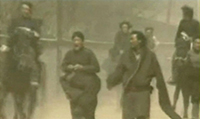




The protests, which have ripped through Tibetan areas of China since last week in the worst unrest there in decades, occurred in Sichuan’s Karze area (in Chinese, Ganzi), on March 18.
“Around 2:05 p.m., a protest took place in Karze town, Sichuan province. ...Both monks and laypersons took part. It was led by two people, Pema Dechen and Ngoga,” one Tibetan witness told RFA.
“The protesters shouted ‘Long live the Dalai Lama,’ and ‘Free Tibet,’ and they distributed leaflets. …The Chinese authorities arrested 10 protesters. One person, Ngoga, who led the demonstration, was killed by gunfire. The other nine were dragged away, and they looked injured, but it wasn’t clear,” the witness said.
There are lots of Tibetan students here. All night long, the police cars kept coming. Ordinarily it’s quiet here. But since the riot in Tibet…
The witness, whose account was confirmed by a second protester on the scene, identified those arrested as Pema Dechen, Gonpo, Tseten Phuntsog, Lobsang, Zangpo, Palden, Gonpo, and two others whose names were unavailable.
Another man, a Buddhist monk, was killed in a separate incident in the same town, according to witnesses.
A group of monks from Dargye monastery planned a protest march but were headed off by police acting on a tip-off as they marched toward the central area of Karze.
“The police stopped them on the way. The monks protested, and one monk was killed by gunfire,” one witness said. The name and age of the monk couldn’t immediately be obtained.
Following Friday’s crackdown in Lhasa during which armed police fired on rioting protesters, violence spread to neighboring parts of China as anti-Chinese protesters took to the streets in Sichuan, Gansu and Qinghai provinces, with large crowds of Tibetans marching on government buildings, and thousands of security forces brought in to seal off Tibetan areas.
Many remote areas of the Sichuan, Gansu, and Qinghai plateau are home to large Tibetan populations, many of whom are nomads.
Tibet also shares an internal border with China’s northwestern region of Xinjiang Uyghur Autonomous Region, home to the Muslim Uyghur ethnic group, who also deeply resent Beijing’s rule.
Uyghurs overseas said China had imposed military restrictions on the southern part of Xinjiang, near the Tibetan border, which included a ban on public assembly. Chinese police denied that such regulations were in force, however.
“Military rule began March 10, a week ago,” World Uyghur Congress spokesman Dili Xiati told RFA’s Mandarin service. “It is forbidden for more than three or four Uyghurs to gather together for an evening, or they will be arrested on suspicion of carrying out illegal activities.”
Exiled Uyghurs on Tuesday voiced solidarity with the Tibetans.
“The World Uyghur Congress condemns China’s use of military force against the peaceful Tibetan protesters in Lhasa and other provinces, and calls upon Chinese leaders to start constructive negotiations with His Holiness the Dalai Lama to seek a peaceful political solution to the problem,” the group said in a statement carried on its Web site.
Authorities in the Tibetan capital have been arresting hundreds of people since a deadline passed Monday for those involved in the marches, demonstrations, and rioting to “surrender” to police.
“The police came over, saying they were checking residence registration cards,” one Tibetan resident told RFA’s Mandarin service. “They looked for many people yesterday based on pictures taken by video monitors. They are searching in residential areas, focusing on two famous temples.”
A Tibetan source in Lhasa described seeing police take possession of the body of a man killed by gunfire on Tuesday.
“His family had planned to take his body away for a funeral, but then the police came to their house and seized the dead body,” the witness said. “The police told the family that they are taking away all the dead bodies to conduct post-mortems and other investigations.”
“They were also told that all the dead bodies in the recent unrest would be cremated together, and that prior to the cremation, the individual families will be contacted and that they would be allowed to pay a visit to the cremation site after the cremation.”
One Tibetan witness described house to house raids in Lhasa on Tuesday, saying police and paramilitary forces are “are raiding Tibetan houses in the Lhasa area, looking for residence permits and taking anyone people who don’t have them.”
Tibetan sources in India said police were carrying out house-to-house raids and taking away Tibetans without valid residency permits for the city. Families were being given no information about the whereabouts of loved ones, and anyone who stepped outside their home risked immediate detention.
Meanwhile, authorities in Beijing threw a police cordon around the Central University of Nationalities, attended by around 300 Tibetan students. A half-dozen security guards manned the front gate and police cars surrounded the campus on Tuesday.
A female resident in the neighborhood described stepped-up security since Monday, adding: “There are lots of Tibetan students here. All night long, the police cars kept coming. Ordinarily it’s quiet here. But since the riot in Tibet…”
Original reporting by RFA’s Tibetan and Mandarin services. Tibetan service director: Jigme Ngapo. Mandarin service director: Jennifer Chou. Translation by Karma Dorjee and Chen Ping. Produced and edited in English by Luisetta Mudie and Sarah Jackson-Han.